1. Hausdorff JM. Gait dynamics in Parkinson's disease: common and distinct behavior among stride length, gait variability, and fractal-like scaling. Chaos. 2009; 19:026113. PMID:
19566273.

2. Vieregge P, Stolze H, Klein C, Heberlein I. Gait quantitation in Parkinson's disease--locomotor disability and correlation to clinical rating scales. J Neural Transm (Vienna). 1997; 104:237–248. PMID:
9203085.
3. Morris ME, Iansek R, Matyas TA, Summers JJ. The pathogenesis of gait hypokinesia in Parkinson's disease. Brain. 1994; 117:1169–1181. PMID:
7953597.

4. Hackney ME, Earhart GM. Backward walking in Parkinson's disease. Mov Disord. 2009; 24:218–223. PMID:
18951535.

5. Bryant MS, Rintala DH, Hou JG, Collins RL, Protas EJ. Gait variability in Parkinson's disease: levodopa and walking direction. Acta Neurol Scand. 2016; 134:83–86. PMID:
26399376.

6. Kelly VE, Eusterbrock AJ, Shumway-Cook A. A review of dual-task walking deficits in people with Parkinson's disease: motor and cognitive contributions, mechanisms, and clinical implications. Parkinsons Dis. 2012; 2012:918719. PMID:
22135764.

7. Peterson DS, Fling BW, Mancini M, Cohen RG, Nutt JG, Horak FB. Dual-task interference and brain structural connectivity in people with Parkinson's disease who freeze. J Neurol Neurosurg Psychiatry. 2015; 86:786–792. PMID:
25224677.

8. Spildooren J, Vercruysse S, Desloovere K, Vandenberghe W, Kerckhofs E, Nieuwboer A. Freezing of gait in Parkinson's disease: the impact of dual-tasking and turning. Mov Disord. 2010; 25:2563–2570. PMID:
20632376.

9. Grajić M, Stanković I, Radovanović S, Kostić V. Gait in drug naïve patients with de novo Parkinson's disease--altered but symmetric. Neurol Res. 2015; 37:712–716. PMID:
25916791.
10. Baltadjieva R, Giladi N, Gruendlinger L, Peretz C, Hausdorff JM. Marked alterations in the gait timing and rhythmicity of patients with de novo Parkinson's disease. Eur J Neurosci. 2006; 24:1815–1820. PMID:
17004944.
11. Kwon KY, Lee HM, Kang SH, Pyo SJ, Kim HJ, Koh SB. Recuperation of slow walking in de novo Parkinson's disease is more closely associated with increased cadence, rather than with expanded stride length. Gait Posture. 2017; 58:1–6. PMID:
28692855.

12. Kwon KY, Pyo SJ, Lee HM, Seo WK, Koh SB. Cognition and visit-to-visit variability of blood pressure and heart rate in de novo patients with Parkinson's disease. J Mov Disord. 2016; 9:144–151. PMID:
27667186.

13. Siepel FJ, Brønnick KS, Booij J, Ravina BM, Lebedev AV, Pereira JB, et al. Cognitive executive impairment and dopaminergic deficits in de novo Parkinson's disease. Mov Disord. 2014; 29:1802–1808. PMID:
25284687.
14. Barbosa AF, Chen J, Freitag F, Valente D, Souza CO, Voos MC, et al. Gait, posture and cognition in Parkinson's disease. Dement Neuropsychol. 2016; 10:280–286. PMID:
29213470.

15. Gelb DJ, Oliver E, Gilman S. Diagnostic criteria for Parkinson disease. Arch Neurol. 1999; 56:33–39. PMID:
9923759.

16. Goetz CG, Tilley BC, Shaftman SR, Stebbins GT, Fahn S, Martinez-Martin P, et al. Movement disorder society-sponsored revision of the unified Parkinson's disease rating scale (MDS-UPDRS): scale presentation and clinimetric testing results. Mov Disord. 2008; 23:2129–2170. PMID:
19025984.

17. Velozo CA, Peterson EW. Developing meaningful fear of falling measures for community dwelling elderly. Am J Phys Med Rehabil. 2001; 80:662–673. PMID:
11523969.

18. Mak MK, Pang MY. Fear of falling is independently associated with recurrent falls in patients with Parkinson's disease: a 1-year prospective study. J Neurol. 2009; 256:1689–1695. PMID:
19479166.

19. Adkin AL, Frank JS, Jog MS. Fear of falling and postural control in Parkinson's disease. Mov Disord. 2003; 18:496–502. PMID:
12722162.

20. Yogev G, Giladi N, Peretz C, Springer S, Simon ES, Hausdorff JM. Dual tasking, gait rhythmicity, and Parkinson's disease: which aspects of gait are attention demanding? Eur J Neurosci. 2005; 22:1248–1256. PMID:
16176368.

21. Herman T, Weiss A, Brozgol M, Giladi N, Hausdorff JM. Gait and balance in Parkinson's disease subtypes: objective measures and classification considerations. J Neurol. 2014; 261:2401–2410. PMID:
25249296.

22. Galna B, Lord S, Burn DJ, Rochester L. Progression of gait dysfunction in incident Parkinson's disease: impact of medication and phenotype. Mov Disord. 2015; 30:359–367. PMID:
25546558.

23. Grimbergen YA, Munneke M, Bloem BR. Falls in Parkinson's disease. Curr Opin Neurol. 2004; 17:405–415. PMID:
15247535.

24. Fasano A, Canning CG, Hausdorff JM, Lord S, Rochester L. Falls in Parkinson's disease: a complex and evolving picture. Mov Disord. 2017; 32:1524–1536. PMID:
29067726.

25. Robinson K, Dennison A, Roalf D, Noorigian J, Cianci H, Bunting-Perry L, et al. Falling risk factors in Parkinson's disease. NeuroRehabilitation. 2005; 20:169–182. PMID:
16340098.

26. Schaafsma JD, Giladi N, Balash Y, Bartels AL, Gurevich T, Hausdorff JM. Gait dynamics in Parkinson's disease: relationship to Parkinsonian features, falls and response to levodopa. J Neurol Sci. 2003; 212:47–53. PMID:
12809998.

27. Lord S, Galna B, Yarnall AJ, Coleman S, Burn D, Rochester L. Predicting first fall in newly diagnosed Parkinson's disease: insights from a fall-naïve cohort. Mov Disord. 2016; 31:1829–1836. PMID:
27621153.

28. Voss TS, Elm JJ, Wielinski CL, Aminoff MJ, Bandyopadhyay D, Chou KL, et al. Fall frequency and risk assessment in early Parkinson's disease. Parkinsonism Relat Disord. 2012; 18:837–841. PMID:
22542094.

29. Kerr GK, Worringham CJ, Cole MH, Lacherez PF, Wood JM, Silburn PA. Predictors of future falls in Parkinson disease. Neurology. 2010; 75:116–124. PMID:
20574039.

30. Son M, Cheon SM, Youm C, Kim Y, Kim JW. Impacts of freezing of gait on forward and backward gait in Parkinson's disease. Gait Posture. 2018; 61:320–324. PMID:
29413804.

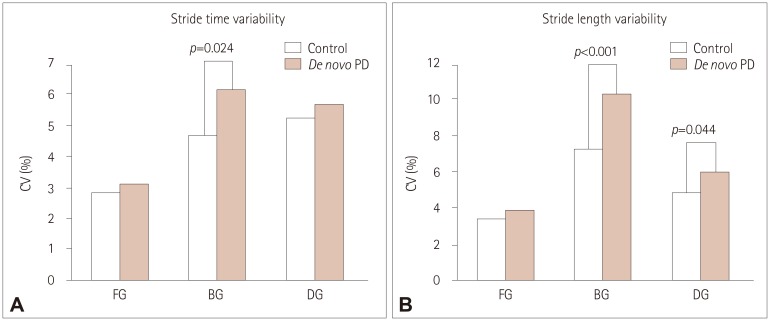
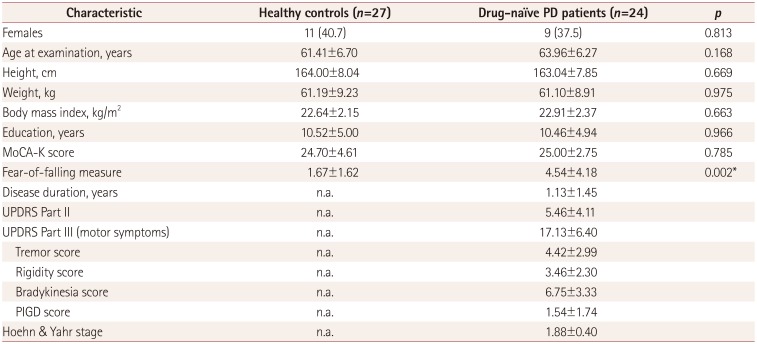




 PDF
PDF ePub
ePub Citation
Citation Print
Print



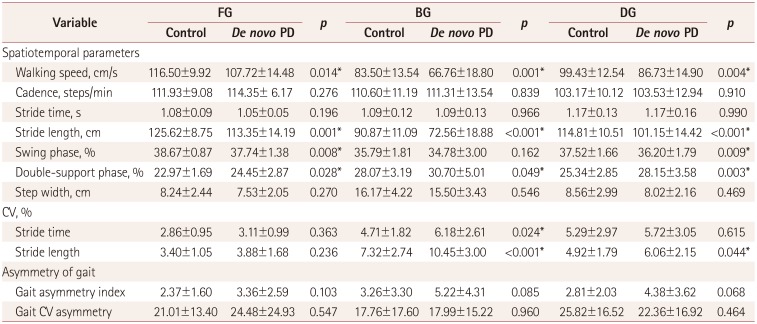
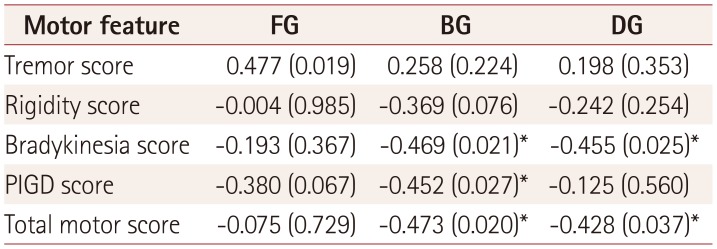
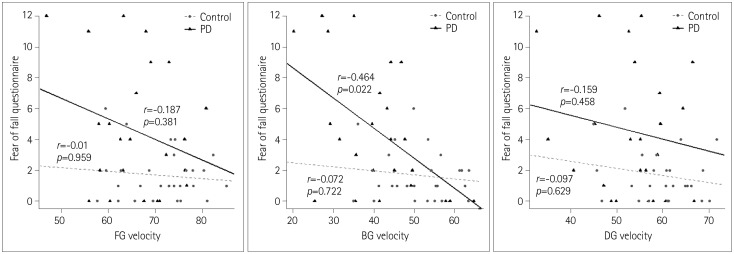
 XML Download
XML Download